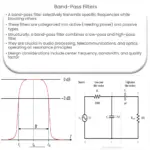Explore the band-pass filter equation, transfer function, filter order, roll-off, design parameters, and an example calculation.
Understanding the Band-Pass Filter Equation
A band-pass filter is an essential tool in signal processing, which allows specific frequency ranges to pass through while attenuating or blocking frequencies outside the desired range. This article discusses the underlying equation governing the operation of a band-pass filter.
Band-Pass Filter Fundamentals
Band-pass filters can be categorized into two types: active and passive. Active filters use operational amplifiers and require a power supply, while passive filters use passive components such as resistors, capacitors, and inductors. Both types of filters are based on the same basic principle of selective frequency response.
The Transfer Function and the Band-Pass Filter Equation
The behavior of a band-pass filter can be described mathematically using a transfer function, which is a complex function relating the input and output signals of the filter. The transfer function, H(ω), is given by:
- H(ω) = Vout(ω) / Vin(ω)
where Vout(ω) is the output voltage as a function of angular frequency (ω), and Vin(ω) is the input voltage as a function of angular frequency.
The band-pass filter equation can be derived from the transfer function by considering the passband, stopband, and transition band of the filter. In the passband, the filter allows signals with frequencies within a specific range to pass through, while in the stopband, signals are significantly attenuated. The transition band is the region between the passband and stopband where the attenuation is neither negligible nor significant.
Filter Order and Roll-off
The sharpness of the transition between the passband and stopband is determined by the filter order. A higher-order filter has a steeper roll-off, which means that the filter attenuates unwanted frequencies more effectively. The filter order is typically denoted as ‘n’ and is an integer value.
The roll-off rate of a band-pass filter can be calculated using the following equation:
- Roll-off rate (dB/decade) = 20n
where n is the filter order.
Filter Design and Parameters
Designing a band-pass filter involves selecting the appropriate components and parameters to achieve the desired frequency response. Key parameters include the center frequency (fc), bandwidth (BW), and quality factor (Q).
The center frequency and bandwidth are related to the lower and upper cut-off frequencies (fl and fh, respectively) by the following equations:
- fc = √(fl × fh)
- BW = fh – fl
The quality factor, Q, is defined as the ratio of the center frequency to the bandwidth:
- Q = fc / BW
These equations provide the foundation for designing and analyzing band-pass filters to achieve optimal performance in a wide range of applications.
Example of Band-Pass Filter Calculation
Let’s consider a passive RC (resistor-capacitor) band-pass filter with the following specifications:
- Lower cut-off frequency, fl = 100 Hz
- Upper cut-off frequency, fh = 1000 Hz
- Resistor, R = 1 kΩ
Using the given specifications, we can calculate the center frequency, bandwidth, and quality factor of the filter. Additionally, we will determine the required capacitor values for the filter circuit.
Center Frequency and Bandwidth
First, we calculate the center frequency and bandwidth using the provided equations:
- fc = √(fl × fh) = √(100 × 1000) = √100000 = 316.23 Hz
- BW = fh – fl = 1000 – 100 = 900 Hz
Quality Factor
Next, we determine the quality factor:
- Q = fc / BW = 316.23 / 900 = 0.35
Capacitor Values
Finally, we calculate the capacitor values required for the band-pass filter circuit. For a passive RC filter, the cut-off frequencies are related to the resistor and capacitor values by the following equations:
- fl = 1 / (2πR × C1)
- fh = 1 / (2πR × C2)
Now, we can solve for the capacitor values C1 and C2:
- C1 = 1 / (2πR × fl) = 1 / (2π × 1000 × 100) ≈ 1.59 μF
- C2 = 1 / (2πR × fh) = 1 / (2π × 1000 × 1000) ≈ 159.15 nF
In summary, we have calculated the center frequency (316.23 Hz), bandwidth (900 Hz), quality factor (0.35), and the required capacitor values (1.59 μF and 159.15 nF) for the specified RC band-pass filter.



